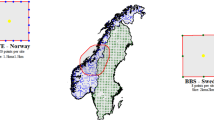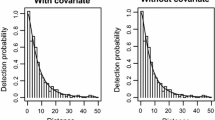Abstract
The aim of this study was to examine the effects of stratification of the survey region on the performance of species distribution models (SDMs) described by generalized linear models or generalized additive models when estimating school abundance by using a line transect survey. True covariates that define spatial school distribution are not always obtainable explanatory variables. When the true covariates differ from explanatory variables in the model, the explanatory variables are determined to be misspecified. We evaluated the performance of SDMs in abundance estimation with misspecified covariates by using dummy datasets for which the true abundance was known. Simulated replicates of spatial distributions of a whale school and sighting data were generated from possible scenarios motivated by the spatial school distribution of Antarctic minke whales Balaenoptera bonaerensis. This distribution was obtained from the Japanese Whale Research Program under Special Permit in the Antarctic. Our results showed that the relative bias of the abundance estimators was large when covariates were misspecified and a survey region was stratified. Although stratification of the survey region is intended to produce a conventional line transect estimator with a smaller variance than that of non-stratified survey region, it also acts to increase the bias of the abundance estimate obtained from SDMs.





Similar content being viewed by others
References
De Segura AG, Hammond PS, Ca adas A, Raga JA (2007) Comparing cetacean abundance estimates derived from spatial models and design-based line transect methods. Mar Ecol Prog Ser 329:289–299
Reeves RR, Smith BD, Crespo EA, di Sciara GN (2003) Dolphins, whales, and porpoises: 2002–2010 conservation action plan for the world’s cetaceans. World Conservation Union, Gland
Buckland ST, Anderson DR, Burnham KP, Laake JL, Borchers DL, Thomas L (2001) Introduction to distance sampling estimating abundance of biological populations. Oxford University Press, New York
Marques FFC, Buckland ST, Goffin D, Dixon CE, Borchers DL, Mayle BA, Peace AJ (2001) Estimating deer abundance from line transect surveys of dung: Sika deer in southern Scotland. J Appl Ecol 38:349–363
Roberts JP, Schnell GD (2006) Comparison of survey methods for wintering grassland birds. J Field Ornithol 77:46–60
Buckland ST, Borchers DL, Johnston A, Henrys PA, Marques TA (2007) Line transect methods for plant surveys. Biometrics 63:989–998
Hedley SL, Buckland ST, Borchers DL (2004) Spatial distance sampling models. Advanced distance sampling. Oxford University Press, New York, pp 48–70
Thomas L, Williams R, Sandilands D (2007) Designing line transect surveys for complex survey regions. J Cetacean Res Manage 9:1–13
Hedley SL, Buckland ST, Borchers DL (1999) Spatial modelling from line transect data. J Cetacean Res Manage 1:255–264
Hedley SL, Buckland ST (2004) Spatial models for line transect sampling. J Agric Biol Environ Stat 9:181–199
Guisan A, Thuiller W (2005) Predicting species distribution: offering more than simple habitat models. Ecol Lett 8:993–1009
Hirzel A, Guisan A (2002) Which is the optimal sampling strategy for habitat suitability modelling. Ecol Model 157:331–341
Reese GC, Wilson KR, Hoeting JA, Flather CH (2005) Factors affecting species distribution predictions: a simulation modeling experiment. Ecol Appl 15:554–564
Begg MD, Lagakos S (1992) Effects of mismodeling on tests of association based on logistic regression models. Ann Stat 20:1929–1952
Brose U, Martinez ND, Williams RJ (2003) Estimating species richness: sensitivity to sample coverage and insensitivity to spatial patterns. Ecology 84:2364–2377
Magnus JR (1999) The traditional pretest estimator. Theory Probab Appl 44:293–308
Dominici F, McDermott A, Zeger SL, Samet JM (2002) On the use of generalized additive models in time-series studies of air pollution and health. Am J Epidemiol 156:193–203
Hoenig JM, Barrowman NJ, Pollock KH, Brooks EN, Hearn WS, Polacheck T (1998) Models for tagging data that allow for incomplete mixing of newly tagged animals. Can J Fish Aquat Sci 55:1477–1483
Jones FA, Muller-Landau HC (2008) Measuring long-distance seed dispersal in complex natural environments: an evaluation and integration of classical and genetic methods. J Ecol 96:642–652
Nishiwaki S, Ishikawa H, Fujise Y (2006) Review of general methodology and survey procedure under the JARPA. Paper SC/D06/J2. International Whaling Commission Scientific Committee, Impington
Murase H, Matsuoka K, Ichii T, Nishiwaki S (2002) Relationship between the distribution of euphausiids and baleen whales in the Antarctic (35 E–145 W). Polar Biol 25:135–145
Ishikawa H, Murase H, Tohyama D, Yuzu S, Otani S, Mogoe T, Masaki T, Kimura N, Ohshima T, Konagai T (2000) Cruise report of the Japanese Whale Research Program under Special Permit in the Antarctic (JARPA) area IV and eastern part of area III in 1999/2000. JARPA Paper SC/52/O20
Hosie GW, Schultz MB, Kitchener JA, Cochran TG, Richards K (2000) Macrozooplankton community structure off east Antarctica (80–150°E) during the Austral summer of 1995/1996. Deep Sea Res II 47:2437–2463
Naganobu M, Hirano T (1986) Environmental factors for geographical distribution of Euphausia superba Dana. Natl Inst Polar Res (Spec Issue) 40:191–193
Environmental Systems Research Institute (2008) ArcGIS 9.3. Environmental Systems Research Institute, Redlands
Meynard CN, Quinn JF (2007) Predicting species distributions: a critical comparison of the most common statistical models using artificial species. J Biogeogr 34:1455–1469
Gilks WR, Wild P (1992) Adaptive rejection sampling for Gibbs sampling. Appl Stat 41:337–348
Matsuoka K, Ensor P, Hakamada T, Shimada H, Nishiwaki S, Kasamatsu F, Kato H (2003) Overview of minke whale sightings surveys conducted on IWC/IDCR SOWER Antarctic cruises from 1978/79 to 2000/01. J Cetacean Res Manage 5:173–201
McCullagh P, Nelder JA (1989) Generalized linear models. Chapman & Hall/CRC, London
Hastie TJ, Tibshirani RJ (1990) Generalized additive models. Chapman & Hall/CRC, London
Cañadas A, Hammond P (2006) Model-based abundance estimates for bottlenose dolphins off southern Spain: implications for conservation and management. J Cetacean Res Manage 8:13–27
Redfern J, Ferguson M, Becker E, Hyrenbach K, Good CP, Barlow J, Kaschner K, Baumgartner MF, Forney K, Ballance L (2006) Techniques for cetacean–habitat modeling. Mar Ecol Prog Ser 310:271–295
R development core team (2011) R: a language and environment for statistical computing. R Foundation for Statistical Computing. Vienna. Available at: http://www.R-project.org/
Wood SN (2001) mgcv: GAMs and generalized ridge regression for R. R News 1(2):20–25
Akaike H (1974) A new look at the statistical model identification. IEEE Trans Auto Control 19:716–723
Acknowledgments
We are grateful to all those who contributed to the collection of cetacean sighting and oceanographic data. We would like to thank members of the Center for Research in Ecological and Environmental Modeling and the School of Mathematics and Statistics at the University of St. Andrews, members of our laboratory, the Center for Ocean Studies and Integrated Education of Yokohama National University, and anonymous reviewers. This work was supported by Grant-in-Aid for JSPS Fellows 201103934 to Y.S., a JSPS grant (10002451), and the Global COE (E-03) by MEXT to H.M. Special thanks to James Lawrence for improving the language of the manuscript.
Author information
Authors and Affiliations
Corresponding author
Electronic supplementary material
Below is the link to the electronic supplementary material.
Rights and permissions
About this article
Cite this article
Shibata, Y., Matsuishi, T., Murase, H. et al. Effects of stratification and misspecification of covariates on species distribution models for abundance estimation from virtual line transect survey data. Fish Sci 79, 559–568 (2013). https://doi.org/10.1007/s12562-013-0634-5
Received:
Accepted:
Published:
Issue Date:
DOI: https://doi.org/10.1007/s12562-013-0634-5




